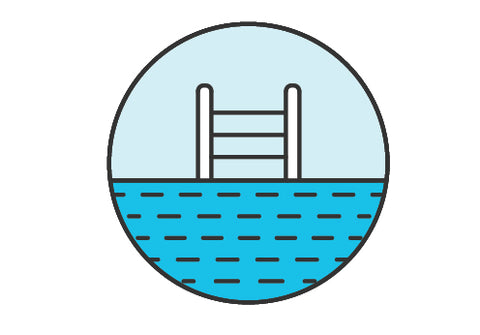Summer is the prime time to savor the refreshing coolness of a river, lake, pond, or pool—or even a dip in the salty sea. Whether it’s a mellow wade or a strenuous swim in pursuit of their favorite floatable toy, many dogs enjoy the water just as much as people do. And, just like with people, it’s important to make safety a priority for swimming dogs. Here are some tips to ensure your favorite furball can indulge in some H20 without any mishaps:
Make sure your dog knows how to swim!
- Don’t just assume swimming is an innate ability. Some dogs need to learn the ways of the waves.
- Flat-faced dogs like bulldogs and pugs not only have short snouts, but their big chests make them top heavy. They can tire easily and potentially sink.
- Puppies usually are not good swimmers and can tire very quickly, so teaching them how to swim and keeping them in shallow water is best.
- Powerful swimmers like Golden Retrievers and Labrador Retrievers will swim and swim and swim and don't always know their own boundaries, keep a close eye on them and always be aware of the risk of hypothermia.
- Start small: choose a shallow, quiet section of water, put him on a leash, and go in with him. Gradually work your way out to slightly deeper water.
- After your dog gets a feel for the water and starts to paddle with her front legs, lift up her hind legs to show her how to float. Remember, not all dogs dig the water, so if she’s not into it, don’t force her.
In a lake, pond, or river:
- Keep your dog a safe distance from all fishing gear; hooks and lines can cause serious injuries.
- Put a life jacket on your dog, especially if you’re out on a boat.
- Avoid water with blue-green algae, which can make dogs sick.
In the ocean:
- Be on the alert for strong currents and rip tides, which can carry a dog out to sea.
- Bring plenty of fresh water along for your dog to stay hydrated; drinking salty seawater can make dogs ill.
- Steer your dog away from sea life that has washed up on the shore. It may smell enticing, but could cause a belly ache and worse!
In a swimming pool:
- Provide steps or a ramp that your dog can use to get in and out of the pool, and show him how to use them. It's very important that a dog is given an easy climb exit in a pool.
- If you use a pool cover, make sure it’s designed to let rainwater through, as dogs can drown in the puddles on top of pool covers.
- For extra safety, enclose your pool with a fence to keep your dog out when it’s not time for a swim, especially if they're not able to get out of the pool themselves.
No matter where you swim:
- Rinse your dog with fresh, clean water when she’s done swimming, since saltwater, algae, chlorine, minerals, and pollution can irritate or damage skin and fur and make them sick if they lick it off themselves.
- Use a soft, dry towel to dry out your dog’s ears after swimming; this prevents infections.
- Swimming is very strenuous for most dogs, so make sure they're given rest breaks with shade and plenty of fresh drinking water.
- Don't let dogs drink lake, river, pool or ocean water, they need fresh water. The chemicals, bacteria, parasites and salt can make them sick.
- Learn canine CPR—yes, there is such a thing! And it can save your dog’s life in the event of an accident in the water.
And of course, don't forget to bring plenty of West Paw Zogoflex® floatable dog toys.





